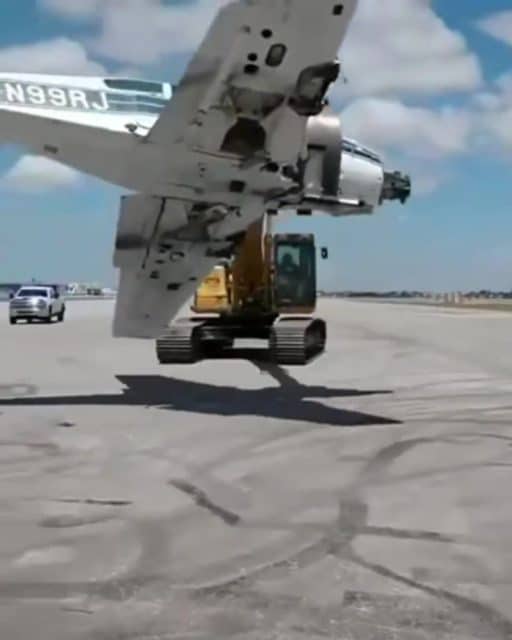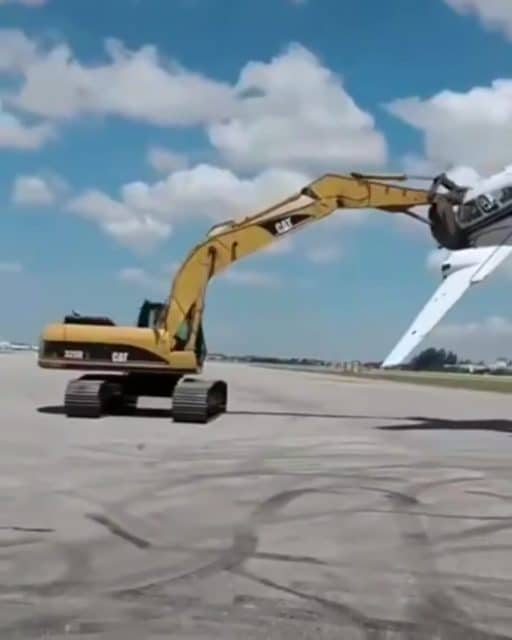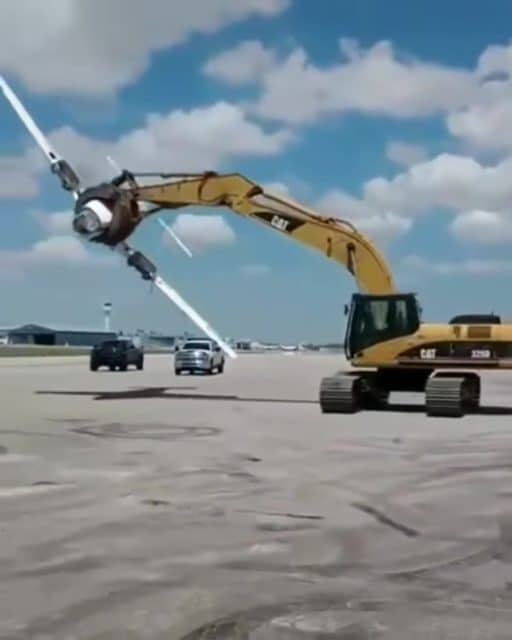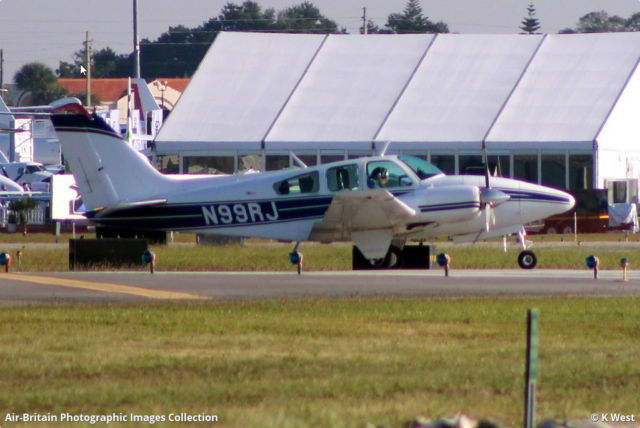Beechcraft Baron final “flight”
New ride opens at Blackpool pic.twitter.com/LWwG95Gj6P
— Andrew Hodgson (@Hoddy1982) May 2, 2020
My friend Rob sent me a link to this with a note that said simply, “I have questions.”
Not everyone can see the video on the tweet, so here’s a high-res version of the video that the tweet is based on — one or the other should work for everyone:
There’s a lot of questions here, starting with “What the hell?” and ending with “Why?”
I’m never one to resist a challenge. Besides, the aircraft registration is clearly visible in the image, so how hard could it be to find out more?
Let’s look at some freeze frames to start.

N99RJ was a privately owned Beech Baron which was deregistered on the 8th of March 2018.

The excavator is a CAT and squinting at the model number I think it starts with 225, as in a Caterpillar 225 Hydraulic Excavator. I can’t seem to quickly find information about how much weight they can lift, and funnily enough, capacity for swinging an aircraft through the air isn’t in their documentation.

On the left side of the image we can see a control tower and a hangar, which confirms that the wide open space here is a runway.
I certainly don’t know my US airports well enough to be able to identify it based on the angle of the hangar and the tower alone, but as the owner of the aircraft had a Florida address and the incident happened in Florida, it seems a good bet that the aircraft was scrapped in Florida too. I know we have some Florida pilots who read this; does anyone recognise it?
Searching on the registration is easy and I found this photograph by K West showing the Beech Baron in better days: 
You can tell it was taken some years ago because the FAA have recorded an accident on the 17th of January 2018 which would not have left it in such pristine condition. The FAA report says that the left main gear collapsed on landing resulting in a propeller strike. This happened in Miami, Florida under Part 91, that is, flying under General Aviation regulations.
Here’s the pilot’s report:
Coming to a full stop landing, left base to final 27R, landing gear handle down, green light on.
Translation: as I was turning to land on runway 27 right, I checked that the landing gear handle was down and the green light (to show that the gear had extended fully) was illuminated.
Translation of the translation: I didn’t screw up.
Normal touchdown, 3 to 4 seconds on the roll out the plane starts moving let to right…
I’m sure that’s a typo and the pilot means that the plane began to swerve left to right.
…resulting in a left main gear collapse first, left propeller hits the ground.
You can tell it is painful even to just talk about it.
Then the nose gear retracts, at that moment the right propeller hits the ground and the right main gear is partially retracted. We secured and exited the plane with no injuries.
So basically, the landing gear failed completely and in the process, both propellers struck the ground, which means a lot of money to check and repair the engines.
The search also showed that this is not the first time that the propellers on this aircraft had taken damage. Sixteen years earlier, under different ownership, the aircraft struck a taxiway light.
Pilot departed FBO Signature Flight support ramp area at Miami International Airport in route to Runway 27R, in darkness and in rainy conditions, and as he was passing thru an unlighted taxiway section and construction area, in which many wooden barriers and temporary blue lights were placed to mark the paralleling taxiway, the aircraft propellers impacted an unlighted taxiway light, causing damage to the aircraft propellers.
And funnily enough, it’s also not the first time the landing gear had collapsed. In 1979, the NTSB investigated an occurrence at Howey in the Hill in Florida, where the landing gear collapsed when the pilot turned off the runway and into soft sand.
NAME OF AIRPORT - HOWEY IN THE HILL
DEPARTURE POINT INTENDED DESTINATION
ORLANDO,FL HOWEY,FL
TYPE OF ACCIDENT PHASE OF OPERATION
GROUND-WATER LOOP-SWERVE LANDING: ROLL
GEAR COLLAPSED LANDING: ROLL
PROBABLE CAUSE(S)
PILOT IN COMMAND - SELECTED UNSUITABLE TERRAIN
FACTOR(S)
AIRPORTS/AIRWAYS/FACILITIES - AIRPORT CONDITIONS: SOFT RUNWAY
MISCELLANEOUS ACTS,CONDITIONS - OVERLOAD FAILURE
It seems the aircraft had an exciting and relatively long life before this recording of its final flight went viral.
The aircraft is listed as scrapped on the 30th of April 2020. The first instance of this video that I could find was dated just a few days later.
[Note: Finally, I found this FlightAware reference of a three minute re-positioning flight on the 22nd of May 2020. It’s clearly an error. There’s no way that N99RJ flew again after being in the jaws of that caterpillar. Besides, the engines had already been removed.]
The only remaining question is why. There’s certainly no practical reason to swing a plane through the air other than for the pure joy of doing so. I strongly suspect that the operator of the excavator was making vroooom noises as the plane swung round. And I’m not the only one. The best comment I saw on this was on Reddit:
What do we want?
Low flying airplane noises.
When do we want them?
NNNNNNNNEEEEEEEEEEOOOOWWWW
I also loved this comic by a Reddit user called Shitty_Watercolour, who draws scenes based on discussion in Reddit threads. It’s a fun thing that he does but this one is probably my favourite ever.









It’s a sad sight to see. When you think of all that goes into making an airplane and all of the lives an airplane has touched, it’s hard to think of it being melted down for a new career in the beverage industry.
I have twice been in the immediate presence of a crashed airliner, the DC9 lost in the late ‘80s, Continental Flight 1713. I saw it in the hangar where they kept it while the investigation was being conducted. A once sleek aircraft, now twisted and deformed. It was sobering, especially when one considers the human loss associated with that crash.
A number of years later, I was on a bike ride in Aurora, CO and saw a trailer parked on a residential street with some of the remaining pieces of that DC9 piled on it. I have no idea why this trailer would be parked in a residential area, but I suspect that the pieces I saw ended up at the smelter very soon thereafter. Once proud, sleek and fast, now it was just scrap aluminum.
I’ve looked up some of the aircraft in my logbook, and to the best of my knowledge, the Beech Sport 150 In which I learned to fly and also used for my Private Pilot’s checkride, is still registered and flying. I find that reassuring, somehow.
The Lockheed Electra I saw at Boston (Logan) in 1976 had died unhappily; I don’t remember the details from so long ago, but it was not the most cheerful thing to see out the window while I was taking the written exam for my instrument rating.
I’ve seen a few wrecks but the first was an Air New Zealand Lockheed Electra at Whenuapai in about 1961. Would you believe that pilots had to demonstrate their ability to force land this bloody great turboprop with all engines on zero power? Sink rate got a bit high and after a desperate flare pretty much everything broke at impact and it caught fire very quickly. So quickly that the crew all had to exit thru the Captains side window: the last out burnt his hands sliding down the fuselage. It was a Saturday morning and a bunch of us were routed out of bed, given rifles and put on Crash Guard. The smell of burnt aircraft and fire foam is still with me.
I’m pretty sure they deleted the power off landing from the Cat Check after that.
Oh my, I actually LOL’ed at that video. So far the highlight of my day. Kudos to the CAT operator for making a small bit of lemonaid out of the situation. I’m betting even the Beechcraft appreciated it. Who wouldn’t want the wind going over their wings one last time.
That would’ve been a weird track if the plane had had the ADS-B transmitter on for that “flight”!
The excavator is a Caterpillar 325D L and weighs around 29 tons; the Beechcraft Baron weighs about 1.4 tons with all parts attached, or about as much as cubic metre of sand, which I imagine the excavator can comfortably deal with.
The video seems to have originally been posted by piloteyes777 on instagram; I don’t have an account there and can’t check back far enough to find that video.
It does look like the scene of that video is Miami Opa-Locka executive airport, the same airport where the plane last landed, with its distinctive control tower visible, set on one of the three short wide runway stubs. The wikipedia entry for it is more interesting than I had anticipated.
I wonder whether there was somebody \in/ the hulk pretending to fly it.
Yeah, he started out pretending to fly, but ended up screaming and pounding on the door.
In the movie The Iron Giant (1999) the title character does this to an automobile with nine-year-old Hogarth Hughes inside. Hogarth thinks it’s a great idea until his ride reaches full speed.
Let’s assume the reach of the differ is 9.8m (it depends on the stick being o stalled and the eaxact height above ground, but I think that’s accurate to +/-1m) and the revolution in the video taking 6.3s (again, a bit inaccurate, could be half a second more or less), then the plane is traveling at an angular velocity of 1/s (2 pi f) and the centrifugal acceleration is exactly 1g. So, for this event, nothing to scream about.
Had the digger been swinging twice as fast, the aircraft would have been pulling 4g, so it pays to check the numbers before you open your own “plane rides on the ground” business. It’s the difference between taking a 10m (30 ft) radius corner at 36 km/h (22mph) or 72 km/h (44 mph) in a car.
Grew up flying in that Baron. Was owned by a law firm my grandfather flew for out of Herndon / Orlando Exec. The gear collapse in Howey was due to trying to maintain enough speed to get through soft wet ground. An attempt to steal an engine occurred in Acadia FL as well. We flew it home with part of engine cowling missing. Good memories